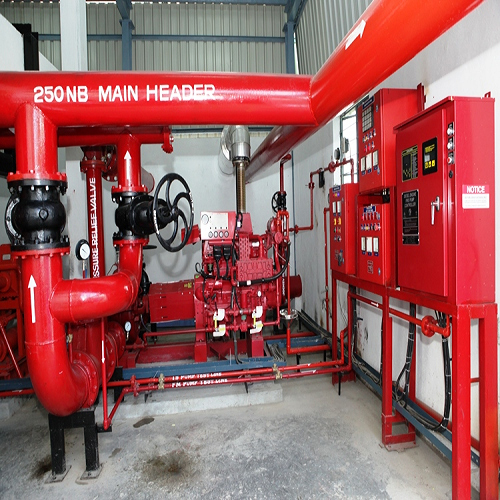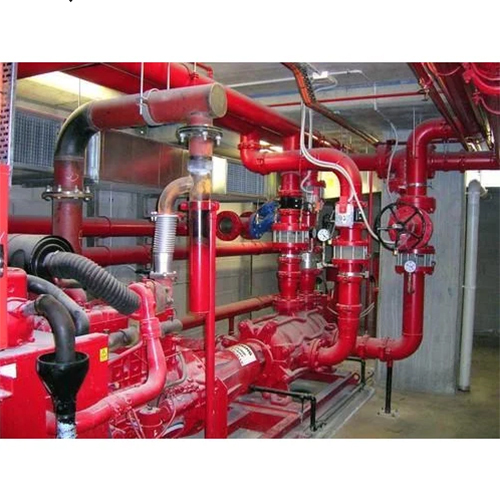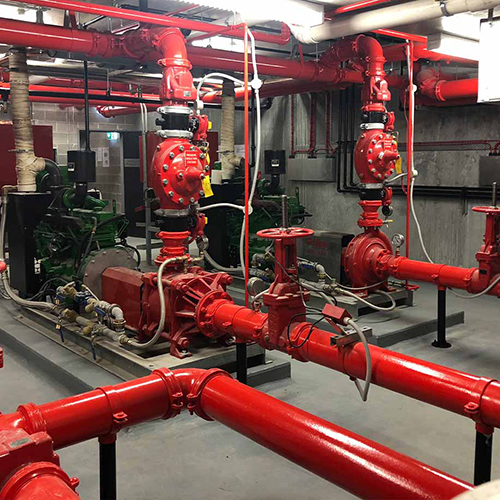A fire hydrant system, often simply referred to as a "fire hydrant," is an essential component of firefighting infrastructure designed to provide a readily available source of water to extinguish fires. These systems are commonly found in urban and suburban areas and are crucial for the rapid response of firefighters to emergencies.
Here are the key components and functions of a fire hydrant system:
1. Fire Hydrant: The most visible part of the system, a fire hydrant is a tall, upright pipe with one or more water outlets. It is typically located at ground level and is painted in bright colors for easy identification. Firefighters connect hoses and other firefighting equipment to the hydrant to access the water supply.
2. Water Supply: Fire hydrants are connected to a pressurized water supply, typically provided by a municipal water distribution system. The water in the system is under pressure and ready for immediate use in case of a fire.
3. Valve Assembly: A valve assembly is located underground, beneath the fire hydrant. This assembly allows for the control of water flow to the hydrant. Firefighters or authorized personnel can open or close these valves to regulate water supply to the hydrant.
4. Piping: A network of underground pipes connects the fire hydrants to the main water supply system. These pipes transport water from the source to the hydrants.
5. Nozzle and Hose Connection: Firefighters use a wrench to open the hydrants nozzle and connect hoses to it. The nozzle allows them to control the flow and direction of the water, making it easier to target the fire.
6. Hydrant Markings: Fire hydrants are often color-coded to indicate the flow rate and available water supply. This helps firefighters choose the most suitable hydrant for a particular fire-fighting operation.
7. Maintenance: Regular maintenance is essential to ensure that fire hydrants are in good working condition. This includes inspections, lubrication, and periodic flow testing to check the water pressure and flow rate.
8. Accessibility: Fire hydrants must be easily accessible to firefighters and not obstructed by vehicles or other objects. Local regulations often dictate specific clearance requirements.
Fire hydrants play a vital role in firefighting efforts as they provide a convenient and reliable source of water near the location of a fire. Quick access to water allows firefighters to respond swiftly and effectively to emergencies, helping to minimize damage and protect lives. Proper maintenance and adherence to regulations are critical to ensure that fire hydrants are always ready for use when needed.
FAQ:
Q. What is a fire hydrant system?
Ans: A fire hydrant system is a network of components designed to provide a reliable source of pressurized water for firefighting purposes. It typically includes fire hydrants, underground piping, valve assemblies, and a connection to a municipal water supply.
Q. How does a fire hydrant system work?
Ans: Fire hydrants are connected to the water supply system, which is under pressure. When needed, firefighters can access the water by opening a hydrants valve, allowing pressurized water to flow through hoses and firefighting equipment.
Q. What are the different types of fire hydrants?
Ans: There are several types of fire hydrants, including dry barrel hydrants (common in colder climates), wet barrel hydrants (common in warmer climates), and high-pressure hydrants for specialized applications. They may also vary in terms of size and flow capacity.
Q. How are fire hydrants maintained?
Ans: Regular maintenance is essential for fire hydrants. This includes visual inspections, lubrication of moving parts, flow testing, and ensuring that hydrants are not obstructed. Municipalities or water authorities typically perform these maintenance tasks.
Q. What is the purpose of color-coding on fire hydrants?
Ans: Color-coding helps firefighters quickly identify the flow rate and available water supply of a hydrant. It assists in choosing the most suitable hydrant for firefighting operations. The color-coding scheme may vary by location.
Q. Are fire hydrants always pressurized with water?
Ans: Yes, fire hydrants are typically pressurized with water at all times. They are connected to the municipal water supply, so water is readily available for firefighting emergencies.
Q. How is the water pressure in a fire hydrant system maintained?
Ans: Water pressure in a fire hydrant system is maintained by the municipal water supply system. Water authorities ensure that the system is pressurized adequately to provide sufficient firefighting capabilities.
Q. Can individuals use fire hydrants for non-emergency purposes, such as filling pools or watering lawns?
Ans: Using fire hydrants for non-emergency purposes is generally prohibited and illegal in most places. Fire hydrants are reserved exclusively for firefighting and emergency services. Unauthorized use can result in fines and penalties.
Q. What should I do if I notice a damaged or leaking fire hydrant?
Ans: If you notice a damaged or leaking fire hydrant, report it to your local authorities or water department immediately. They will dispatch personnel to assess and repair the hydrant as needed.
Q. Who is responsible for the installation and maintenance of fire hydrants?
Ans: The installation and maintenance of fire hydrants are typically the responsibility of local municipalities, water authorities, or relevant government agencies. Private property owners are responsible for keeping hydrants on their property accessible and clear of obstructions.


